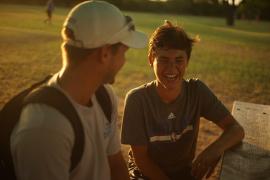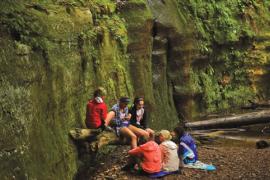The word character carries weight.
It evokes images of resilience, courage, and kindness under pressure — qualities we hope to develop in our children and refine in ourselves. Yet character, like the people who embody it, is not static. In the landscape of human development, we must ask ourselves, “What does it mean to be wide-awake to the formation of character?” As I’ve watched young people navigate their journeys of becoming, I’ve come to understand character not as a fixed constellation of virtues, but as a dance of consciousness — an ongoing dialogue between the self and the world.
Character bends and stretches, evolving through experience and environment. It is as much about where we are as who we are — as much about the culture we absorb as the time in which we live. Yet within these shared influences, character remains deeply personal and individual, expressing itself uniquely through each person’s particular combination of strengths, sensitivities, and ways of engaging with the world. Like art that awakens us to new ways of seeing, character emerges through moments of revelation; through encounters with what is possible. When we speak of character, we are speaking of freedom — freedom to become, to transform, to imagine alternatives to what is. These transformative moments often occur in unexpected places through challenges that test our assumptions and push us beyond our comfort zones.
For decades, camps have served as fertile ground for character development. The American Camp Association’s Character at Camp Initiative reminds us that the stories we carry from our summers spent outdoors — leading a hike, sharing responsibility for cabin chores, comforting a homesick bunkmate — are not just memories. They are markers of growth. These experiences, often simple and unassuming, lay the groundwork for a lifetime of resilience, empathy, and purpose.
Each camper’s journey is uniquely their own as they discover and develop their individual strengths while contributing their distinct voice to the community. My own research has shown that these seemingly modest moments of challenge and connection have lasting impacts on young people’s development, shaping their approach to relationships, responsibilities, and personal growth long after they’ve left the camp environment.
Beyond the Measurable: The Soul of Noncognitive Skills
Character does not show up on a transcript. It doesn’t fit neatly in a spreadsheet or rubric. And yet, it may be the single most important skillset we can cultivate in our children. These so-called “noncognitive skills” — traits like grit, emotional regulation, social awareness, and a growth mindset — are the invisible tools young people carry into a world full of noise, challenge, and change. Recent research in educational psychology has begun to illuminate just how crucial these skills are, not just for academic success, but for life outcomes across all domains.
The University of Chicago report Teaching Adolescents to Become Learners (2012) offers us a framework to understand these skills: perseverance when we falter, self-discipline when distractions abound, curiosity when the path is unclear, and teamwork when the task is too big to handle alone. These are the skills that camps nurture so effortlessly, because camps, unlike traditional classrooms, don’t test for them — they reveal them through authentic challenges and real-world problem-solving opportunities.
At camp, grit is not a buzzword; it’s the moment when a camper hikes through blisters and mosquitoes to reach the summit and looks back, realizing the view was worth every step. Social awareness is not a lecture; it’s learning to listen to a cabinmate’s fears in the dark of night. Consider Rachel’s story of pitching a tent with her peers. What seemed like a basic skill at the outset became a lesson in patience, problem-solving, and teamwork. As the sun set and frustration mounted, she recalled feeling overwhelmed — until they paused, regrouped, and found a solution together. That shared success was more than an accomplishment; it was a moment of growth, a step toward consciousness of her own capabilities and the power of collective resilience.
Time: Character Through the Lens of Generations
Character has always been shaped by its era. Throughout history, different periods have called for different expressions of character virtues. There was a time when character meant obedience and punctuality, virtues necessary in the factory-bound world of the Industrial Revolution. The Victorian era emphasized moral rectitude and self-control. The World Wars demanded courage and sacrifice. The Civil Rights Movement called for moral courage and peaceful resistance. Each generation has faced its own unique challenges that shaped their understanding and expression of character.
Today’s generation, growing up in the flickering glow of screens and the persistent hum of uncertainty, faces challenges their grandparents could scarcely imagine. For them, character is adaptability — the ability to tune out distractions, regulate emotions, and persist through complexities that defy easy answers. They must navigate a world where information is abundant, but wisdom is scarce; where connection is constant, but genuine relationship can be elusive.
Camps offer what Ruth Vinz (1996) calls “thick time” — moments when young people can step outside the rush of ordinary experience and become conscious of their own becoming. In the quiet rhythm of sunrise hikes and evening campfires, campers find a steadiness that the hurried outside world so rarely allows. This slowing down creates space for reflection and growth that our usual rushed pace doesn’t often permit.
For Lydia, profiled in the November/December 2015 Camping Magazine article “Where They Are Now — Confirming the Important Work Camps Do,” character was built in the incremental moments of leadership. Leading her group down a hiking trail, organizing cleanup duties with her cabinmates — she didn’t just learn to take charge; she learned to listen, to collaborate, and to serve. Her story illustrates how leadership emerges not from grand gestures but from consistent, mindful engagement with daily challenges.
Place: Where Character Finds Its Roots
Place is more than location; it is environment, opportunity, and experience all woven together. Place is where character takes root, where it is tested and refined by the demands of the world around us. A young person growing up on a farm may develop grit and responsibility through early morning chores, learning the rhythms of nature and the importance of consistent effort. Another, raised in a bustling city, may learn adaptability and social awareness by navigating its fast-moving rhythms and diverse population.
But place, at camp, is something extraordinary. Camp is a deliberate space — a place where young people can step outside the familiar and into an environment designed for growth. The physical separation from home creates psychological space for new possibilities. The natural setting provides both challenges and comfort, teaching resilience while fostering connection to something larger than oneself.
For John, another camper highlighted in my research, camp was a place to discover resilience. Homesick and hesitant during his first summer, John learned to adapt. He found friendship where he expected isolation and strength where he saw weakness. The physical setting — the woods, the cabins, the trails — became both the setting and the catalyst for this transformation. Years later, he would reflect that those weeks of homesickness taught him more about his own capabilities than any academic challenge he’d faced.
Culture: The Compass That Guides Character
Culture serves as both mirror and window — reflecting who we are while opening vistas of who we might become. If time sets the context and place provides the stage, culture points the way. Culture tells us which traits to nurture, which values to honor, and how to express them. In some cultures, perseverance is quiet and collective, working tirelessly for the good of the group. In others, it is bold and singular, pushing an individual to achieve personal dreams. Neither is right nor wrong; each reflects the unique values of its people and the challenges they face.
In a camp setting, culture operates as what Maxine Greene (1978) would call a “landscape of learning” — a space where different narratives intersect, where young people can imagine themselves and their world anew. These “third spaces” (Oldengurg, 1989) become laboratories for the social imagination, places where different cultural stories can meet and transform each other. A bilingual camper introducing new words to a friend becomes both teacher and learner, discovering their own capacity to bridge worlds. An urban student finding strength in wilderness challenges learns that capability comes in many forms.
The culture of camp is intentionally crafted to support growth and discovery. It’s a culture that celebrates effort over perfection, that values process as much as outcome, and perhaps most importantly, honors the unique path each individual takes in their character development. While shared values provide a foundation, camp culture creates space for personal expression and individual interpretation of these values. It’s a place where mistakes are viewed as learning opportunities and where support comes from all directions — peers, counselors, and the community as a whole.
Mentorship and Awakening: Practical Implications for Educators
Like artists who help us see the world anew, skilled camp counselors and mentors create conditions for awakening. Their role is not to instruct but to invite consciousness — to help young people become aware of their own agency in shaping character. When a counselor truly listens or holds a group accountable, they’re engaging in what I call embodied pedagogy — teaching through conscious presence rather than prescription.
Consider Marcus, who struggled with confidence. He found himself leading a group problem-solving activity and realized that leadership is not about being the loudest voice but about building trust. This discovery came not from formal instruction but through the gentle guidance of counselors who created space for such realizations to emerge. His counselors modeled authentic leadership by stepping back, allowing natural consequences to teach, and helping him reflect on his experiences.
The lessons we learn from camp environments about character development have profound implications for educational practices beyond the summer months. In addition to the need for intentional design of both physical and social spaces to create more meaningful character-building opportunities. The assessment of character growth needs to shift from standardized measurement to observation and reflection that honors individual paths of development. Just as no two fingerprints are alike, no two character journeys follow exactly the same course. Rather than trying to quantify character development, we can document growth through narrative assessment and the collection of meaningful moments that demonstrate character in action. This approach honors the complex, nonlinear nature of character development while still providing valuable feedback about a child’s growth.
Camps, as well as institutions outside of camp, can intentionally create what I call “character moments” — opportunities for young people to exercise and develop their character strengths in authentic ways. This might include:
- Structured peer mentoring programs that develop leadership and empathy
- Community service initiatives that connect to academic learning
- Challenge-based learning projects that require persistence and teamwork
- Cross-cultural exchange opportunities that build cultural competence
- Youth-led conflict-resolution programs that develop emotional intelligence
We can work to create “third places” — spaces between home and formal learning where character can develop naturally through interaction and experience. In addition to camp, these places might be after-school programs, clubs, or informal gathering spaces where young people can practice being their best selves without the pressure of formal evaluation.
The Lifelong Journey of Character
Character development, like the pursuit of consciousness itself, is never complete. It is an ongoing process of awakening to possibility, shaped by time, place, and culture, but always open to transformation. What camps offer — and what all educational spaces should strive for — is the opportunity for young people to become wide-awake to their own becoming.
In an era focused on measurement and quantifiable outcomes, we must remember that the most profound learning happens in moments of awakening — when young people become conscious of their own agency in shaping who they become. Character development at camp reminds us that growth is not about accumulation but about consciousness, not about achievement but about awakening.
And camps? They’re where many of these stories begin, where young people first discover that character isn’t about who they are in any given moment — it’s about who they’re brave enough to become. For in the end, character is about becoming conscious of who we might be — and awakening to the possibilities that lie before us.
Photo courtesy of Camp Friendship, Palmyra, VA.
References
Farrington, C.A., Roderick, M., Allensworth, E., Nagaoka, J., Keyes, T.S., Johnson, D.W., & Beechum, N.O. (2012). Teaching adolescents to become learners. The role of noncognitive factors in shaping school performance: A critical literature review. Chicago, IL: University of Chicago Consortium on Chicago School Research.
Greene, M. (1978). Landscapes of learning. New York, NY: Teachers College Press.
Oldenburg, R. (1989). The great good place: Cafes, coffee shops, bookstores, bars, hair salons, and other hangouts at the heart of a community. New York, NY: Paragon House.
Ozier, L. W. (2015, November 1). Where they are now — Confirming the important work camps do. Camping Magazine. ACAcamps.org/article/camping-magazine/where-they-are-now-confirming-important-work-camps-do
Vinz, R. (1996). Composing a teaching life. Portsmouth, NH: Boynton/Cook Publishers, Heinemann.
Lance W. Ozier, EdD, was born and raised on a Georgia farm and now lives in New York City. He has taught and worked in Atlanta and NYC public schools for over 20 years. A graduate of Teachers College, Columbia University, he has been on the faculty of The City University of New York since 2009. After spending 15 seasons in the Catskill Mountains at Morry’s Camp, Lance received a Hedley S. Dimock Award in 2015 and has also served on several ACA research advisory committees.



